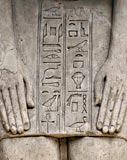Since
Antiquity the Egyptian hieroglyphs remained forgotten, mysterious
script. In 1822 Jean-François Champollion deciphered the pronounciation
of the signs and the structure of the script, using the bilingual
text of the famous Rosetta Stone. But even now, after almost two
centuries of the development of Egyptology, the Greek word hieroglyphs
(meaning 'sacred engravings') is understood as referring to complicated
symbols, hiding primeval secrets, and difficult to be decoded.
The truth is, however, that today we are able to read not only
the texts cut on the walls of temples and tombs, or letters and
accounts written in haste on pottery sherds, but even the ancient
Egyptian cryptography.

The
exhibition 'Speech of the Gods. Egyptian Hieroglyphs' in the Poznań
Archaeological Museum is intended to refer to the new temporary
exhibition on the Chinese script (the Chinese signs being called
hieroglyphs as well, and both cultures being often compared).
At the same moment it is an addition to the permanent exhibition
'Death and Life in Ancient Egypt' - beside the posters with information
on the most important aspects of the Egyptian script, there are
translations of the texts on some of the objects. The dictionaries
and handbooks for learning hieroglyphs are presented in several
cases, as well as the collection of contemporary items (from childrens'
toys through jewellery), decorated with hieroglyphs.

The exhibition is organized under the auspices of Thoth, the god of wisdom.

